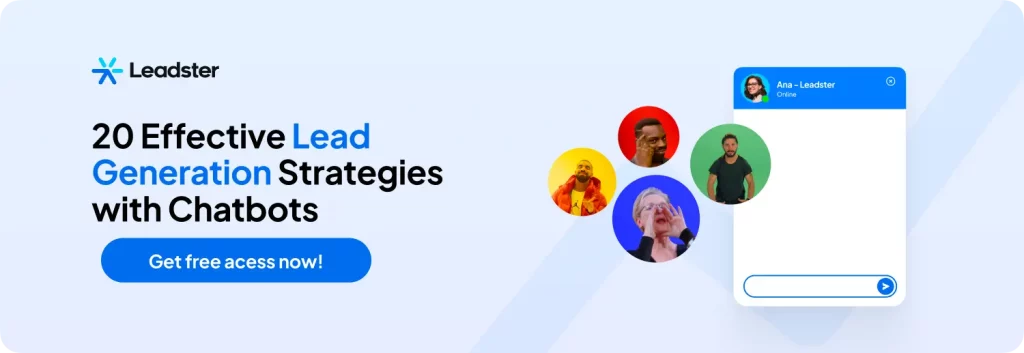What is Conversational Commerce? How to Do It?
With the advancement of AI and its practical applications, conversational commerce has shifted from being an abstract, “future” concept to a real possibility that you can implement today.
Yes, today—seriously. There are already tools— which we will analyze throughout this article—specifically designed to track sales in a conversational way.
The topic of today’s article is this: how exactly does conversational commerce happen? And how has it already been happening?
It’s important to understand that despite the innovative nature of conversational commerce and the launch of new tools that make it easier, it has already been applied, even in simpler forms.
To understand exactly what conversational commerce is, let’s start by exploring where it is already taking place.
Shall we begin?
Understanding Conversational Commerce: How Is It Already Applied?

If the name doesn’t make much sense to you, conversational commerce is the practice of offering your customer or prospect the ability to be assisted via messages throughout their journey.
🤿 Dive deeper: Customer Journey: What It Is, How to Do It, and Examples
In other words, it’s about being available for sales opportunities through immediate responses to any questions about the purchase process or the product.
And in some cases, it means being proactive and actively pursuing sales through personalized messages sent to prospects according to their stage in the Marketing and Sales Funnel.
That is, conversational commerce is already a reality, but it is expanding.
How exactly this reality unfolds is what we will analyze in this section at the beginning of the article.
Let’s go:
Email Marketing and Conversational Commerce
One of the main Inbound Marketing strategies, especially for Lead Nurturing, email marketing is probably one of the oldest conversational commerce strategies still in use.
In e-commerce, email marketing operates on multiple fronts simultaneously, but it is most commonly used for abandoned cart recovery and customer re-engagement.
The abandoned cart email, in fact, is probably the oldest known conversational commerce strategy.
Back in the early days of e-commerce, email was the only way to connect with customers outside of phone calls.
The strategy works quite simply: by analyzing the primary cookies of your site, you can understand customer behavior.
This allows you to identify leads who added products to their cart but did not complete the purchase. Knowing this, and ensuring that the person is a lead (having provided contact details), you can send an email.
This is a very common Inbound strategy for e-commerce—one that isn’t always widely applied but delivers excellent results.
Customer re-engagement is another common strategy: since the customer is already registered, you can analyze how long it has been since their last purchase and send an email with special offers.
These strategies are classic and have been used for years in e-commerce, even long before social media.
However, social media has introduced another dimension to conversational commerce, making it worth discussing further. Read on:
Social Media and Conversational Commerce
Social media brings another layer to conversational commerce—one that goes beyond simply “sending messages to prospects and leads.”
The most basic role of social media in conversational commerce is customer service.
There are already specialized tools for organizing comments and direct messages, as well as for automatic replies.
(We have an article with several platform recommendations for this purpose.)
But social media expands the concept of social commerce in a much broader way. You can interact with individual customers through automation platforms, but also engage with your entire target audience through your posts.
Creating a Reels video showcasing a product is also conversational commerce, though in a different form.
Doing an unboxing, a live promotion, a product comparison, and so on—all of these qualify as conversational commerce since they use content and articles to present a product to your audience.
Push Notifications and WhatsApp
Another common tactic in conversational commerce is using push notifications and WhatsApp at various stages of the customer’s Buying Journey.
Push notifications are SMS messages sent to leads already registered in your system. WhatsApp works similarly but changes the delivery platform.
Generally, push notifications and WhatsApp strategies focus more on converted customers since they have already shared their contact information with your brand.
However, you can also generate leads through the other strategies we’ve discussed so far and use this contact database to enhance your push strategy.
That said, these strategies often resemble advertisements more than conversations.
That’s because, when sales-oriented, these notifications don’t necessarily invite a conversation. In fact, conversation isn’t even the goal.
The use of instant messaging platforms, such as WhatsApp and Telegram, also plays a significant role in conversational commerce in another interesting way.
Let’s explore that in the next section:
WhatsApp and Telegram Chatbots
Today, one of the most popular methods of implementing conversational commerce is through customer service chatbots.
There is some debate about whether this strategy qualifies as conversational commerce. Remember: conversational commerce occurs when conversation is essential to the customer’s purchasing process, right?
These chatbots are typically linked to menus where customers or prospects interact with the brand to seek support, check product prices, or even complete a purchase.
So, we can indeed include WhatsApp and Telegram chatbots as part of conversational commerce since sales occur through conversation.
However, it’s not just sales that happen in this context. As we’ve discussed, support, general information, and answering inquiries also take place through these channels.
Those who argue that chatbots don’t qualify as conversational commerce are ignoring key aspects of the Customer Journey.
Support is part of the post-sale experience. Answering customer inquiries directly impacts sales.
We have two tutorial-style articles explaining how to create customer service chatbots, each with three different methods. Check them out below:
➡️ How to Create a Telegram Chatbot? The Easy and Hard Way
➡️ How to Create a WhatsApp Chatbot? 3 Methods + Examples
There are various ways to implement conversational commerce. The ones we’ve covered so far are the most popular, but as you can see, they are part of other strategies.
That’s the biggest issue with how conversational commerce is typically executed today. It is a subject, not the entire discipline.
High-performance conversational commerce happens in more specific situations—especially at the moment of sale.
Let’s discuss these points next. Follow along:

How to Implement Advanced Conversational Commerce?
Now that we understand that conversational commerce is a way to boost sales through close and useful customer interactions, let’s explore its practical applications.
This fundamental principle will guide you in your conversational commerce experiences.
What changes are the methods used to initiate these interactions.
Today, conversational commerce can be divided into two broad categories:
- Conversational commerce outside your website – all the platforms and strategies we’ve mentioned so far, which integrate conversational techniques into broader marketing methodologies.
- Conversational commerce within your website – any opportunity to communicate with site visitors with the goal of making a sale.
Defining the goal of conversational commerce is crucial to avoid misunderstandings about what it does and what it truly is—and its goal is always to sell.
There are many conversational approaches with different objectives, but throughout this article, we are focusing on those aimed at driving sales.
Conversational commerce happens through conversation. Therefore, on-site CC solutions will always involve chatbots.
There are other ways to communicate within your website, no doubt.
However, if you want to converse with leads and visitors, you need to work with chatbots.
But even conversational commerce via chatbots on your site operates in different ways. Let’s explore them further below:
Conversational Commerce for Lead Generation
Leadster’s main mission has always been to generate new leads for your company. Since the development of our first chatbot, the idea has been a proactive approach to contact generation in a simpler way.
Our original chatbot provides a service that is still somewhat difficult to find on the internet today: offering CTAs on any page of your site, at any time, through the chatbot.
You can see it in action right here on this page, in the bottom-right corner.
Notice how this chatbot operates through menus and simple, quick, and direct conversations.
It can be used at various stages of the Funnel—by the way, this link here provides great examples of how exactly this happens.
At the Top of the Funnel, you can offer e-books, webinars, and any type of rich material to your visitors.
In the Middle of the Funnel, more in-depth and closer content, such as specific newsletters.
And for the Bottom of the Funnel, the chatbot can guide the user to the contact page, provide the company’s contact number, etc.
All of this is based on the page the visitor is reading. For example: on this page you’re reading, we use Top of Funnel copy because this is a blog you probably found on Google while searching for “conversational commerce.”
If this were a Pillar Page covering everything about the topic, we would use Middle of Funnel approaches. And if it were a contact page, we would use Bottom of Funnel approaches.
This works very well for any type of company, as long as they follow the basics of Inbound Marketing.
But there is another, much more advanced way to do conversational commerce directly on your site:
Conversational Commerce for E-commerce: Sales Support
E-commerce businesses can use conversational commerce in a much more advanced way, and they constantly do, in fact.
The most advanced way to use CC in this case is as sales support. Leadster’s ShopBot is a great example of this.
With ShopBot, you have a chatbot for your e-commerce installed directly on all your pages.
This chatbot uses ChatGPT to generate responses, so there’s no need to create any menus—the conversation develops naturally.
ShopBot understands what is on the page the user is reading and also understands what is on your site.
Imagine a user wanting to know about a color variation of one of your products. Without the chatbot, they wouldn’t have anyone to ask.
This is the most advanced way to do conversational commerce today.
And as we’ve seen, all forms of conversational commerce are, in fact, ways to put you in contact with your customer.
All of them are easy to install. For Inbound strategies, you will need an Inbound platform, which already provides the necessary tools to start your conversational commerce this way.
For WhatsApp and Telegram chatbots, we’ve already covered the step-by-step guide right here in this article.
Now it’s time for you to experience and understand the power of conversational commerce on your own site. Take a guided test today by clicking on the banner below.







